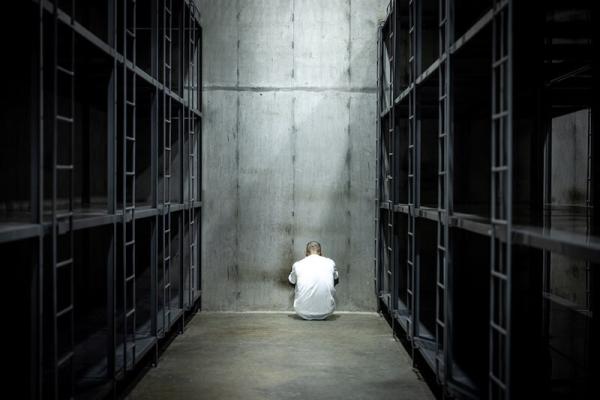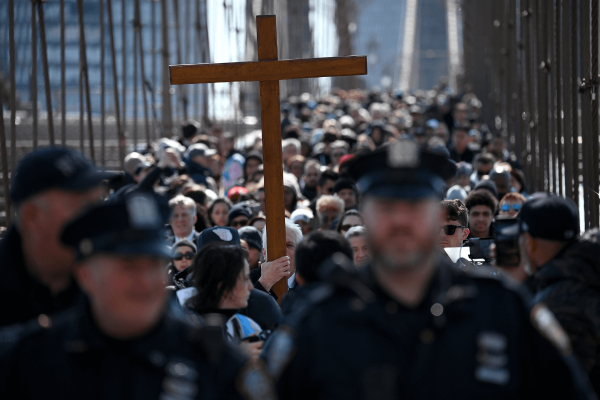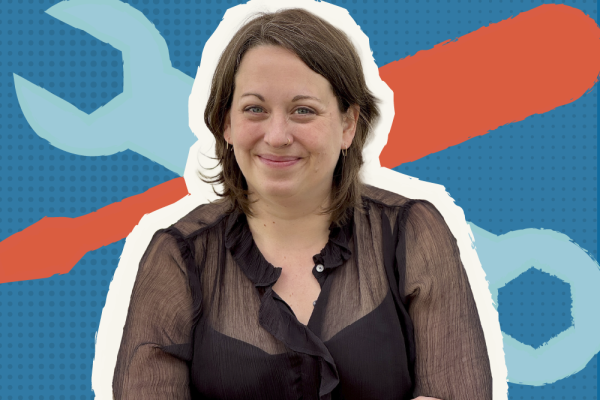Lupe, a cheerful and elaborately tattooed former gang member I’ve known for years as a pastor and friend, just got home from prison. He’s on a new house-arrest program for the tail end of his sentence, so as we hugged and sat down to catch up over coffee last week, there was a clunky ankle monitor bulging beneath one of his bright white socks.
To avoid mounting gang politics within the prison, he opted to spend his last three months in solitary confinement. There’s no TV or news in the “hole,” so Lupe had been unaware of the Kyle Rittenhouse trial until it appeared on his flat-screen TV in his living room.“Who’s this kid?” he asked me.
The news cycle looped the familiar footage of a then-17-year-old Rittenhouse walking the dark Kenosha, Wis., streets with a semi-automatic firearm, approaching and then firing at people he perceives to be rivals.“More gang violence, huh?” Lupe shook his head. “Looks like the white boys are at it again.”
For a veteran of gang violence in recovery, it’s not hard to recognize.
I told Lupe the basics: how a Kenosha cop shot a Black man, Jacob Blake, in the back last summer; how protesters took to the streets and counterprotesters, including white militia groups, showed up armed for a fight; how Kyle Rittenhouse — a teenager in Illinois who’d engaged in pro-police ideology, attire, symbols, and language — drove 20 miles across state lines and joined counterprotesters with an assault rifle and a first-aid kit so that he could back up his chosen allies.
“What if,” I asked Lupe, “a little homie, a Mexican kid who hadn’t been officially jumped in yet, showed up at a big fight downtown with a gun and shot and killed two people?”
“Happens all the time,” said Lupe. “Those youngsters are the ones you gotta be afraid of. They’re trying to prove themselves. Earn their stripes from the chiefs. So let’s see: That’d be two murder ones. They’d break that fool off for life. If he’s got a good lawyer, though, he might cut a deal for 40 or 50 years.”
“But what if he took it to trial and said he shot them because was afraid for his life — and pleaded self-defense?”
Lupe threw his head back in laughter so hard the couch rocked a little beneath us.
“No, seriously,” I said. “What if a little Mexican homie was in court, really arguing this with his lawyer? Oh, and that he’d brought a first aid kit with him, too. What would you say?”
“Well,” Lupe scratched his head and shrugged, “I mean, come on: What’s he doing on the streets with a gun?”
I tried to respond with the very sincere worldview held by many in our country: “It’s his Second Amendment right to carry a gun in America, right?” Lupe stared at me. He had forgotten, just for a moment, about the different set of laws and standards used to judge white people in the United States.
I was honestly curious now: “Have you ever seen a homie with a gun assault plead their Second Amendment right to bear arms as a member of a constitutionally protected militia?” — an argument Rittenhouse’s attorney considered using.
“Uh,” he paused. “No. I been in and out of prison since I was 12. I’m 44 now. I’ve heard a lot of dudes in the pen talk up their cases. Never heard of that. What we get is a gun enhancement — five years on top of the assault charges. Not to mention gang enhancements on top of everything else.”
Days earlier, I had delivered a presentation to over a hundred Washington State judges on the use of these racialized “aggravated sentences,” which allow courts to add an unrestrained amount of years to the standard sentencing range if the crime was intended, in part, to benefit the gang, its reputation, or increase the defendant’s standing within the gang.
My fellow presenters told the judges of their migrant childhoods — picking strawberries, cucumbers, and hops in the fields at an early age; fearing law enforcement’s predatory practices toward their Spanish-speaking families in rural areas; and enduring threats and bullying from white kids at school — all on top of problems in their own homes. All three of them dropped out and got recruited by gangs on the streets or, as happened with the youngest, Valentino, online.
Valentino's virtual recruitment led to a real-life prison sentence. Now Valentino is home from prison, working a landscaping job, and undergoing laser treatment to remove his tattoos. He shared how getting involved with a gang online led to him firing a gun from the backseat of a car one night with other gang-attracted teens. Thankfully, he didn’t hit anyone. Regardless, this 17-year-old went to prison for 10 years on drive-by shooting charges with a “gang enhancement.” As a chaplain, I regularly visited Valentino in juvenile detention back then. We both watched as white kids in our Bible studies got mental health treatment — not gun charges, not gang charges, not adult charges — for shooting their guns at others in the community.
The United States, regrettably, is still struggling to right the longstanding racial bias in our courts and policing. But one area we have entirely failed to examine is who gets labeled as a “gang” and what gets labeled as “gang activity.”
Try a quick online search for posed images of “street gangs.” Then do the same for “Oath Keepers,” a far-right, anti-government militia group. Set these images of armed, organized men beside each other. One group is portrayed as a social cancer, a network of teenage terrorists. The other group is portrayed as a legitimate gun club. Whether we agree with their assessments, both groups believe the government has failed to keep them safe and have taken organized self-protection into their own hands.
Like Valentino, Kyle Rittenhouse was raised by his mom, experienced bullying, and dropped out of high school. So when Rittenhouse broke down on the stand last week, I recognized his meltdown, his tears. That’s a real trauma response in youth who’ve committed great violence. I’ve seen it many times when soft-faced teenagers recount to me moments of life-threatening terror in gang warfare. They all felt very afraid for their lives when they pulled the trigger. They all felt they “didn’t do anything wrong” at the time. Like Rittenhouse, these young gang members did exactly what their subculture had taught them to do.
Before the shooting, Rittenhouse attempted to justify his presence that night by saying, “people are getting injured and our job is to protect this business.” Though not yet initiated into the local Kenosha Guard gang, he saw himself as part of this vigilante militia. He crossed state lines to back up their turf. Every gang member I know shows up to fights not out of hate for enemies but to defend the barrio — literally, the neighborhood.
As I was writing this, the smaller charge of “illegally possessing a dangerous weapon as a minor” had just been dismissed by the judge. In Wisconsin law, it turns out, only shorter-barreled guns are illegal for teens to carry. This statute was written in the early ’90s when gang violence was regularly in the national news and lawmakers responded in most every state. If Kyle Rittenhouse had carried a smaller self-defense handgun, a pistol, something crude or sawed off, he’d be guilty. The weapon he wielded was a much larger, longer, more expensive AR-15-style “assault” rifle. This is a weapon that only more privileged citizens can afford (and it is often proudly brandished on social media or on front lawns).
But the verdict is in: a nearly all-white jury has acquitted Rittenhouse on all charges.
I’m angry. But not because I wanted this kid to go to prison. As a Christian abolitionist, I don’t want prison sentences for anybody — not for Rittenhouse who walks free now after murdering two people in the streets, not for any of the thousands and thousands of men and women who have already been sentenced to living burial in our mass tomb system for much lesser crimes; I believe prisons, in the end, only multiply violence and its many factors.
Rather, I’m angry that the jurors sat in the same room with this young man and believed his self-defense story. I doubt they would’ve offered the same grace to people like Lupe or Valentino. I hope that the Rittenhouse trial forces us to reckon with the disparity in our criminal punishment system.
What I did want from Rittenhouse’s trial — or the trial of anyone who commits a violent act — is accountability. Justice that restores must begin with owning our wrongs. Only this can lead to the the hard work of mending our ways as individuals and as a community, helping heal the harm we’ve caused. As a chaplain, I have seen violent and racist individuals reckon with their sin and rewrite their futures. If Rittenhouse were held accountable, I believe such transformation might be possible for him.
But if the jury — with much of America — buys this young man’s self-defense story, I honestly wonder if this case could set set a new precedent in our country’s courts and imaginations. Can white U.S. citizens, through Rittenhouse’s wide eyes, now imagine that other teenagers walking the streets at night with a gun, like little Lupe and Valentino — looking for a fight, looking to belong, lost inside a bad story — might also be afraid for their lives?
Got something to say about what you're reading? We value your feedback!







